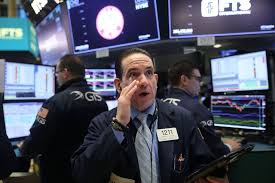The ‘Perfect Cocktail’: Manufacturing and Growth Fears Send the Dow Diving Nearly 500 Points

Markets were rattled Wednesday as disappointing manufacturing data, slowing jobs growth, and signs of global economic stalling pulled the Dow down over 489 points at the close.
All of the major indexes were off more than 1.5% percent Wednesday, with all 11 sectors of the S&P down and the Nasdaq dropping 1.6% to close at 7,785.25. The sell-off comes after the Institute for Supply Management reported Monday that its U.S. manufacturing index dropped in September to the lowest level since June 2009. To boot, underlying trade war concerns and lackluster job growth have added to growing worries of global (and U.S.) recession.
During intraday trading, the S&P 500 hit its lowest point since August—closing down more than 1% for the second consecutive day since last December’s sell-off. “It’s been a long time that we’ve seen a quarter start off so poorly,” Ryan Detrick, senior market strategist for LPL Financial, tells Fortune.
Detrick notes that this October comes after a fairly calm September (bucking its usual trend), which did not see any 1%+ drops. And for Detrick, “you could say things were ripe for some volatility.” He claims that the the culmination of protests in Hong Kong, impeachment proceedings inching closer, and the recent manufacturing numbers “sound like a perfect cocktail for the regular October volatility.”
But some analysts are not too worried—yet.
“It’s important not to get too over-excited over technical things like [the S&P 500’s consecutive 1% drop],” says Michael Reynolds, investment strategy officer at Glenmede Trust. “We continue to see, across the spectrum—whether it’s retail sales, contribution to GDP reports—[consumers] continue to be the engine of this economic expansion.”
And other analysts aren’t seeing the end of the world with Wednesday’s drop either.
“We need to keep in mind that corrections are normal events in the stock market, it’s just part and parcel of the market itself,” SEI’s James Solloway told Fortune. “While we would not look for a decline as sharp as we had in the 4th quarter [last year], a correction that brings down 10% or more from the peak in the market … would not necessarily be the end of the world, and perhaps provide more of a buying opportunity as long as the U.S. economy doesn’t fall into recession.”
But the operative phrase—”as long as the U.S. economy doesn’t fall into recession”—is what seems to be making some investors squirm.
Slowing growth in the global economy, particularly Europe and China, seems to be working its way to the U.S., as manufacturing data (albeit only roughly 10% of the economy) is steadily weakening. And while investors await services data this week (which makes up the remaining roughly 90% of the economy), analysts suggest keeping a cool head.
“It bears to be a little bit on the cautious side at this point if you have a very near-term point of view,” SEI’s Solloway suggests. While Solloway concedes that what last year was his “worst case scenario” has now become his “base case,” he maintains the firm doesn’t see this week’s plunge turning into a “rock ‘em, sock ‘em sort of bear market,” but may actually be a possibility to buy at a discount and wait for upside into next year. LPL Financial’s Detrick agrees.
And even though manufacturing data sent a chill through the markets, Glenmede’s Reynolds says that the new orders component of the index (what he calls “the leading indicator of the leading indicator”) has largely stayed the same month to month.
Stocks leading the plunge
Some of the biggest stocks that pulled the markets down? Delta Air Lines dropped during the day, as did aluminum parts maker Arconic—and some tech giants Apple, Alphabet, Amazon and Microsoft also closed down by 2.5%, 2.3%, 1.3%, and 1.8% respectively.
Quips Glenmede’s Reynolds: “It’s going to be a busy week.”
More must-read stories from Fortune:
—What’s behind the great CEO exodus of 2019?
—What’s the difference between a recession and a depression? Here’s what history tells us
—Charles Schwab on the lessons he’s learned over a lifetime of investing
—The 5 most valuable unicorns, according to their latest funding rounds
—Wells Fargo’s new CEO spent 25 years learning from Jamie Dimon—now he’s taking him on


